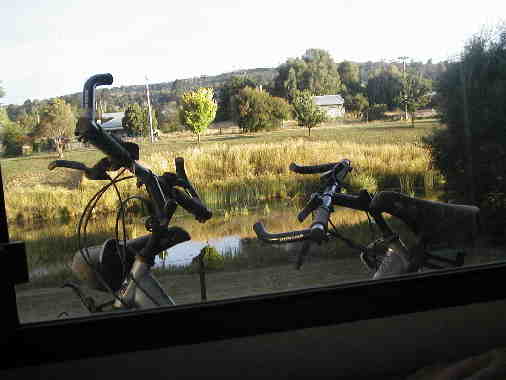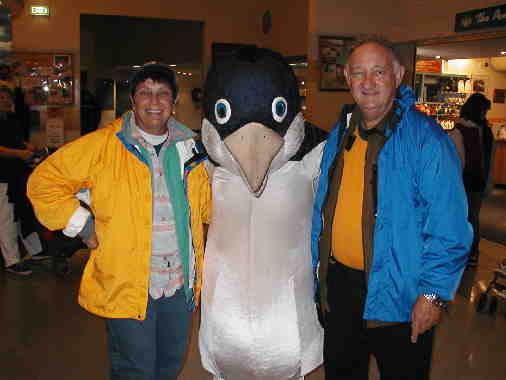
SOUTH-EASTERN VICTORIA
21 January 2002 to 29 January 2002
After leaving Melbourne we drove to Phillip Island to see the nightly Penguin Parade. About half an hour after sunset a few penguins could just be discerned as they emerged from the waves and hopped and waddled across the kelp. The Little Penguin is surprisingly small, smaller than a gull. When it was dark the area was floodlit and we could clearly see each new wave of penguins as they came ashore in their thousands. They preened themselves, waited, then finally waddled and hopped to their sand burrows, passing right next to us. The hills resounded with the cries of hungry chicks that had come out of their burrows, impatiently anticipating their dinner of regurgitated fish. The chicks are huge; because they are fluffy they seem even larger than the poor parents, some of which have to walk 2 kms, a great distance for such ungainly walkers with full stomachs. Fortunately males and females take turns to find food. Photography is not allowed, so instead we’re attaching a picture of a giant penguin that we found.

Phillip Island, only a few hours south of Melbourne, is also home to seals, nesting silver gulls and Mutton Birds, Short-tailed shearwaters that migrate from Alaska to breed here each year. We did the Woolamai Coastal walk, 9-km along beach and cliffs and through banksia (protea-like shrubs) and tea tree thickets. It was a gorgeous day for walking – bright sunlight with a cold Antarctic wind blowing. The Mutton Bird eggs are laid in sand burrows along the tops of the cliffs. Actually January is the hatching period. We saw many burrows but no chicks; we did see many dead adult birds, the work of feral cats and other introduced predators - the eggs are supposed to have a low survival rate, not the parents.
Our next stop was at Wilson’s Promontory. We were delighted to learn
that the National Park reserves a few places for overseas visitors even
over packed Australian long-weekends. We decided to hike to Tongue’s
Point. We must have misunderstood the woman at the Visitor’s Center:
the hike was not 6-km but over 12-km and rather than undulating we felt
that we were climbing uphill most of the way. The picture shows just
how tired I was that day. When we reached the shore we loved the huge
granite rocks, which reminded us of Virgin Gorda in the Virgin Islands.
There was that same kind of ancient feeling as if fingers from another
time had come to visit. Back at the campsite there was a sign warning
about wombats – oh how we’d love to see a wombat!
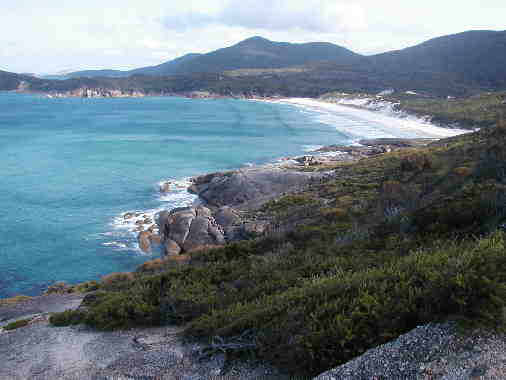
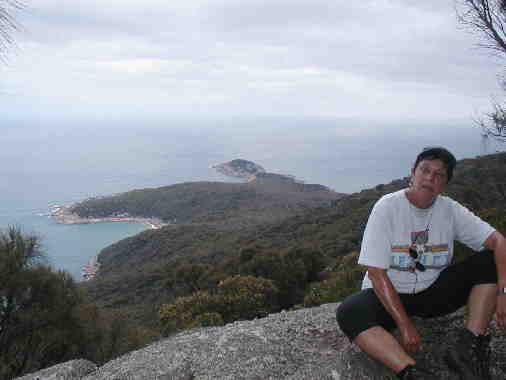
We made a little detour from the Gippsland Highway to Port Albert,
because it’s supposed to have the best fish and chips in Victoria. When
we eagerly arrived at the tiny port we were in a quandary where to eat
since there were two fish shops. A quick question to a man eating in
his car directed us to the famous shop. We decided against flake (very
popular shark) and had duck-fish and flathead instead. We sat on a park
bench overlooking a wetland reserve in the icy wind and relished the
best fried fish we’ve ever tasted! The batter was from a rice flour
combination and it was light and crispy – superb. The chips were also
very good. We didn’t even leave a crumb for the very aggressive seagull
that chased away all comers.
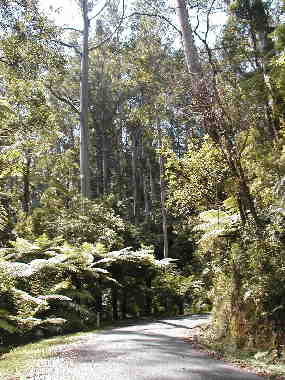 We then cut inland to the Tarra Bulga National
Park and were delighted by the narrow and very windy road as it passed
through a canopy of trees. We stopped at the lovely Cyathea Falls to
walk in a fern gully and admire a ‘river’ of tree ferns alongside the
road. By now we knew enough about temperate rain forests to recognize
the myrtle beech that gave a canopy of shade to the tree ferns, mosses,
lichens and other ferns. Towering up to the sunlight, 60m high,
bordering the gully and beyond, were the mountain ash – a eucalypt.
Whereas the temperate rainforest is slow growing, the mountain ash can
only reproduce when its seeds are released in fire – so if there is
fire it will extend its range down into the gully replacing the burnt
beeches, but if there isn’t fire the rainforest will extend its range
up the banks, encroaching upon the mountain ash. A very fine balance.
The Tarra Bulga rainforest is famous for its lyrebirds and we were
fortunate to see one with its two incredibly long tail feathers dashing
off into the undergrowth.
We then cut inland to the Tarra Bulga National
Park and were delighted by the narrow and very windy road as it passed
through a canopy of trees. We stopped at the lovely Cyathea Falls to
walk in a fern gully and admire a ‘river’ of tree ferns alongside the
road. By now we knew enough about temperate rain forests to recognize
the myrtle beech that gave a canopy of shade to the tree ferns, mosses,
lichens and other ferns. Towering up to the sunlight, 60m high,
bordering the gully and beyond, were the mountain ash – a eucalypt.
Whereas the temperate rainforest is slow growing, the mountain ash can
only reproduce when its seeds are released in fire – so if there is
fire it will extend its range down into the gully replacing the burnt
beeches, but if there isn’t fire the rainforest will extend its range
up the banks, encroaching upon the mountain ash. A very fine balance.
The Tarra Bulga rainforest is famous for its lyrebirds and we were
fortunate to see one with its two incredibly long tail feathers dashing
off into the undergrowth.
As we drove on the highlands we saw flocks of cockatoos. When we
stopped by a tree to look closer there was a loud fluttering of wings
and from the grass arose a flight of birds like an Escher drawing.
At Eagle Point we stopped at the Silt Jetties. Although it looks as if the river has carved a path through the valley, in actual fact the river has been appreciably narrowed by the build up of silt flowing through it. Eitan went fishing. When he caught only one bream that was too small for a meal Eitan reluctantly filleted his fish which we added to our seafood medley with generous splashes of Pernod and enjoyed a delicious marinara spaghetti.
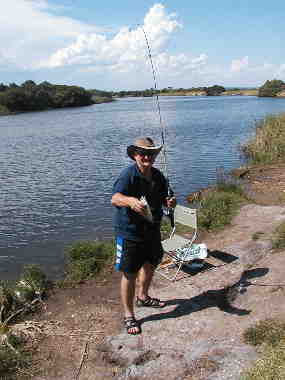
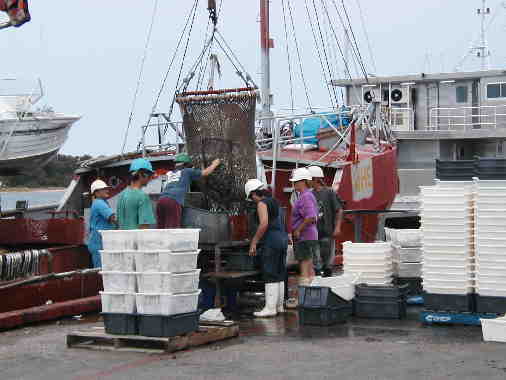
The fish festival continued when we arrived at Lakes Entrance, which has the largest commercial fishing fleet in Australia. Early Monday morning, which was a long weekend, we bicycled along the pier and stopped to watch a crane with a large net scooping out little fish from the hull of a fishing vessel. The fish were then packed and stacked high on a waiting truck. The people were friendly and didn't mind chatting. The fish were pilchards, for bait and cat food. But I remembered eating canned pilchards many years ago in South Africa and I thought that because they were so fresh, we could eat them like sardines. The foreman said if we would wait he would get us a plastic bag and sell us a kilo of pilchards, or as many tons as we wanted. They were unloading 50 tons of fish that day and did it as often as there were fish. After some time the foreman came and said that since we were so poor that we didn’t have a car (we were on our bicycles) he would charge us $2.00! Half we fried and ate. They were like the best sardines. The other half we salted and then put in oil and they were like plump and not so salty anchovies. Oh what a life, living off the fat of the land.
We stopped at Orbost, a tiny inland town, to see a mosaic done by Rural Women of the Snowy River, protesting and hurting the degraded conditions of the river. Unfortunately pictures don’t do it justice. What moved me was the blurb sheet with comments by the handful of women who participated in the project. Any woman who has been involved in women’s projects will hear her feelings expressed in one of the comments by the participants: “The project taps into a wealth of human capital [Rural Women] which is the core of rural communities and has massive potential to change all manner of things through local knowledge, networks, example and involvement. Through the positions they occupy in families and in the wider world and through commitment to coping with change within their communities.”
Let me tell you a little more about living on the ledge. To wash the floor I first spray it with some all purpose cleaner and then tear off a few sheets of paper towels, throw them on the floor and with my shoe rub rub it over the linoleum floor. A few more dry sheets and the floor is clean and dry. In our motorhome there are no spaces, so our ledge bed is above the driver’s cabin and right behind it is the cutlery draw with the micro below it and our cosmetic draw below that. Next to that is a cupboard with pots and pans and vegetables. The sink and stove sit on top and when we wash dishes water splashes onto the stove. When I sit at the eating table I am right next to the tiny fridge and were my arms a little longer I could stretch out and remove the kettle from the stove, or open the tiny grill below it. Eitan sits on the other side next to our minute cupboard on top of which is our cellphone (+61-438845707 if anybody would like to say hello), computer and CD.
To understand the next story: biltong are spiced strips of air-dried
beef, a South African favorite, even better than peppermint crisps –
South Africans would kill for biltong. Cousin Mark had given us a
present of biltong made by an ex-South African living in Melbourne.
One evening we stopped at a caravan park far off the main road. The
sign on the road advertised itself as an adventure caravan park. After
the long drive on a rutted sandy road we thought the name was well
given. But we didn't know that the true adventure was still to
come.
When I was ready to go to bed I kissed Eitan goodnight. He was
engrossed in a game of freecell, computer solitaire. Walking to bed I
saw an enormous brown spider with hairy-bristly legs on the
stove. "There's a spider!" "Okay Dor," as he continued engrossed
in his game. Panic struck I called, "Come quickly." This time Eitan did
take notice. He got out a pair of pliers and caught it by a hairy leg,
but the spider grabbed on to the grate of the stove and pulled itself
free. Try to imagine this scene - the spider runs down to the grill and
Eitan tries to light the fire to kill it. It then reappears in the
cutlery draw so he removes the draw and throws it to the narrow
passage, but the spider runs to the cupboard with the pots and pans.
Eitan has his hands deep in the cupboards with matches and pliers. All
this time I am standing with my toes curled and offering to get Eitan a
pair of gloves so this obviously killer spider won't bite him. With the
cutlery, draws, pots and the pans now strewn all over the narrow
passage Eitan looks in horror into the cupboard and says, "Perhaps the
spider is eating the biltong." He unwraps the biltong and while he is
still trying to catch the spider with his left hand his right hand is
holding onto a strip of biltong from which he is tearing off bits and
chewing furiously. When both hands were eventually free, he managed to
catch the spider and kill it. I still don't know whether he was afraid
that the spider would really eat the biltong or whether he thought that
if this was one of those terribly poisonous Australian spiders, he
might as well die happy with his stomach full. I wanted to go home;
obviously our next visitor would be a hissing tiger snake. When Eitan
looked up about the spider it said it fed on frogs and small birds but
made no mention of biltong.
After spending a night in Bombala and (through the rear window) watched platypuses feed in the river, I felt more relaxed, but it was a relief to arrive in Canberra and some urban scenery.
